What's your dog’s poo telling you?

(No, it doesn't speak but it can tell you a lot)

This guide to your dog's poo will provide plenty of insight in their health and digestive system. You should be looking for a light to dark brown colour in your dog’s stools, they should also be firm and easy to pick up – the perfect poo. Continue reading to learn what the colour, consistency and contents of your dog's poo means and how to improve the quality of your dogs stool.

1. Colour

Colour can give a great insight into your dog’s health and digestive system. You should be looking for a light to dark brown colour in your dog’s stools – the perfect poo.
It is common for raw-fed dogs to produce stools that turn white within 24 hours however if your pup’s stools are being released with a white, chalk like consistency this can be caused by too much calcium (excess bones) in their diet. You can read more about White Dog Poo.
Stools with a grey colour to them can be a sign of too much fat being present in their diet or an issue with their pancreas. This is a tricky one to determine yourself, you may want to use our DooDoo Diary (see below) to track their diet and digestion, but we recommend chatting about this one with your vet to check there are no pancreatic issues. Try to obtain as much info as possible to share with your vet so they get as much of the picture as possible. Learn more about Grey Dog Poo.
Orange stools may be caused by food with artificial colouring or simply carrots in their diet.
Green stools can be caused by your pup eating too much grass, or a sign of biliary or gall bladder issues. If you’ve confidently ruled out grass eating as the reason, and it hasn’t settled after a few days, then it’s time for a chat with your vet. Got more questions about Green Dog Poo?
Red blood visible in their stools can indicate that there is bleeding in the lower digestive tract or from a rectal injury. Darker stools, almost black, can be an early sign of digested blood present from bleeding in their digestive tract. Both of these scenarios are best discussed with your vet.
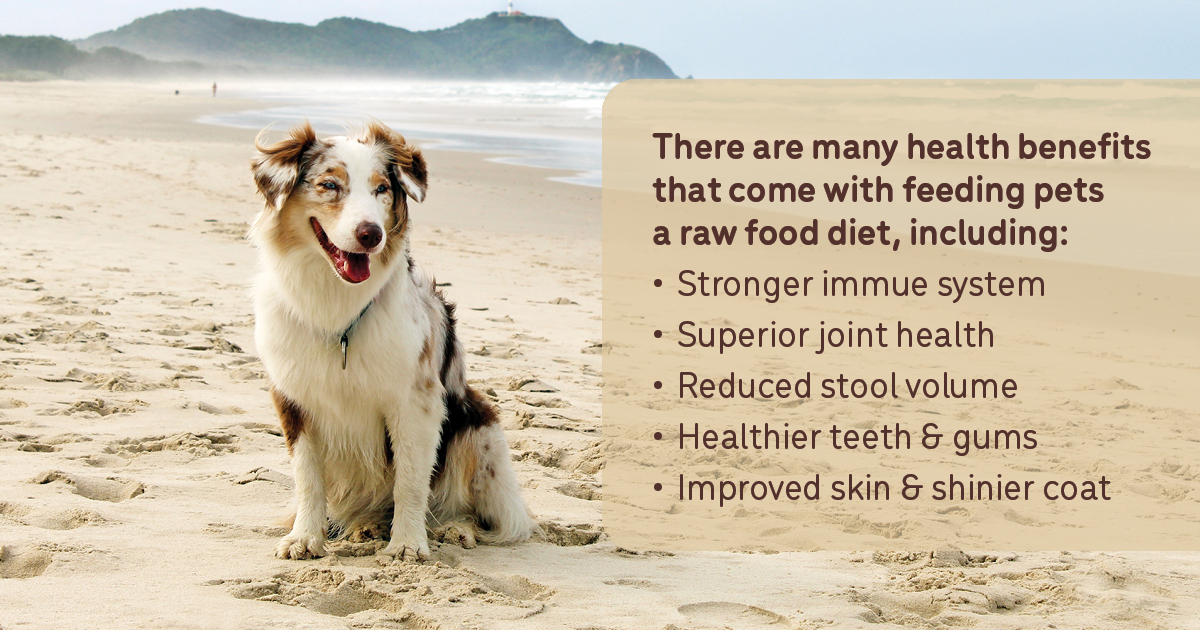
2. Consistency

Hard stools can be difficult and uncomfortable for your dog to pass and may also indicate dehydration. Raw diets have a high moisture content, helping greatly with their hydration levels. Some first timers can struggle with the change due to bone being introduced to their diet– it can be helpful to add a small amount of coconut oil (try ½ a teaspoon per meal) to assist with passing while their systems are adjusting.
The consistency of your dog’s stools should be firm and easy to pick up. Stools that are large and sloppy can be common in dogs that are fed diets high in carbohydrates and processed diets.
Diarrhoea is a clear indicator your dog has eaten, or been exposed to, something that may have disagreed with them; it could also be a change to a high fat diet or treat.
Watery diarrhoea can be a sign of stress or infection and can also lead to dehydration. If your dog is an adult, you should fast them for 6 – 12 hours and allow their gut to rest and heal (it is not recommended to fast a growing puppy – seek vet advice). Monitor them closely and if diarrhoea continues for more than 12 hours, consult your vet.
Stools that consist of both firm and soft parts can be an indicator of irritable bowel syndrome (IBS) or when your dog may be struggling to absorb all necessary nutrients from their food. Chat with your vet to determine the cause and consider a consultation with a qualified animal nutritionist once you have a diagnosis.
We have this guide of helpful information if your dog is constipated.
What can you do?
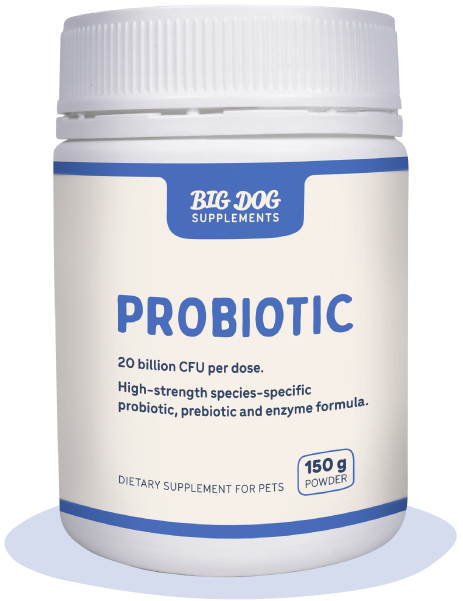
Probiotics are a great addition to your dogs diet, to improve their gut health and stool. Big Dog Probiotics are high-strength and contains canine-specific strains to give your dog the best. The Saccharomyces cerevisiae strain, included in our probiotics improves stool consistency and frequency, as well as aids in reducing inflammation and improving nutrient digestibility. You can find out more about our probiotics and which is the right option for your dog here: Best Probiotic For Your Dog.
85% of pet parents have noticed improvements in their dog's stool quality after switching to a raw food diet. Pet owners report that their dogs' stools are firmer, smaller, and less odorous, with many also noticing a reduction in the frequency of bowel movements. This is largely attributed to the natural, highly digestible ingredients in raw food, which are more easily processed by a dog's digestive system compared to high processed foods. As a result, raw feeding not only promotes healthier digestion but also contributes to overall well-being, making it a popular choice for many pet parents seeking to improve their dog's health.
3. Contents
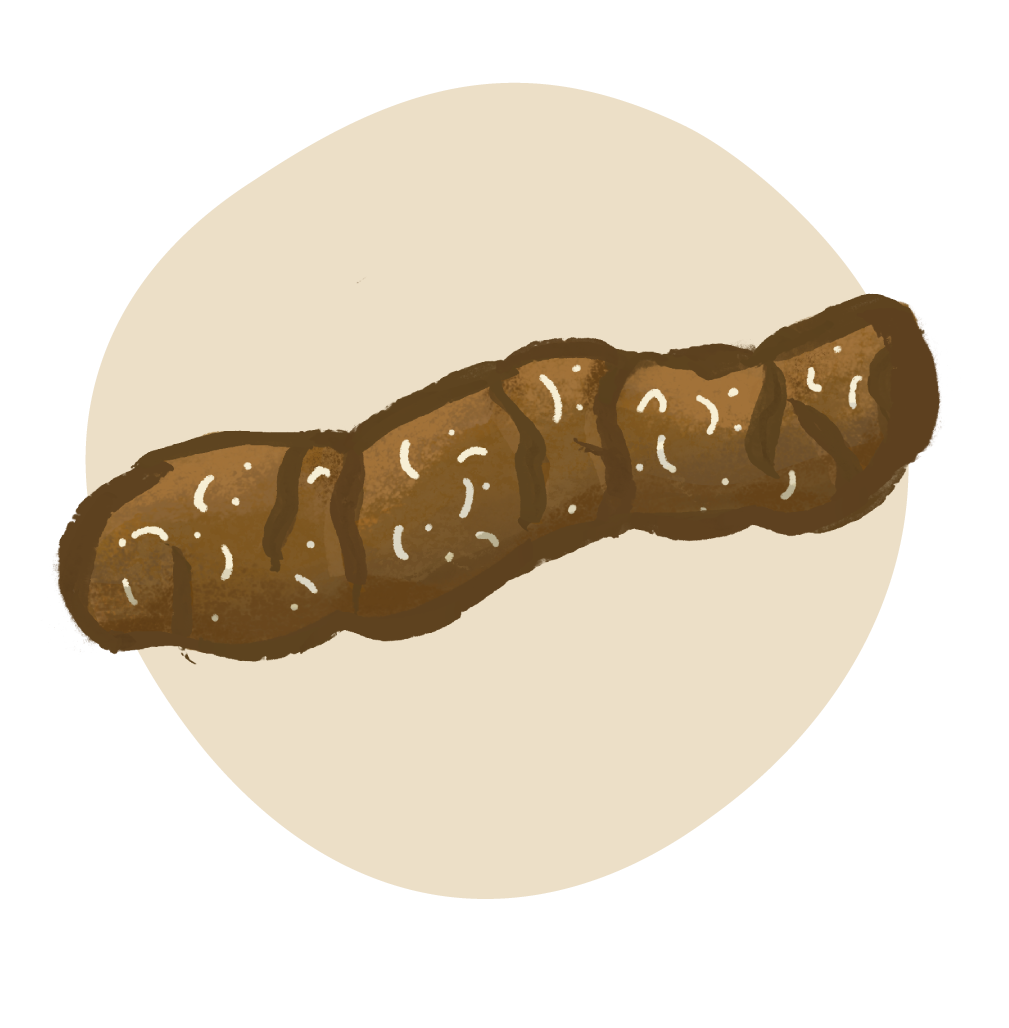
You may see some interesting contents in your dog’s poop from time to time – grass, leaves, rocks, parts of their toys, but you shouldn’t be seeing worms. Worms present in your dog’s diet can be picked up in exposed environments (eg. the dog park). They can be an indication of infection so ensure to pop into your vet and find the right worming medication for your pup. It’s also common to find grass in your pup’s stools which can also be indicated by a green stool.
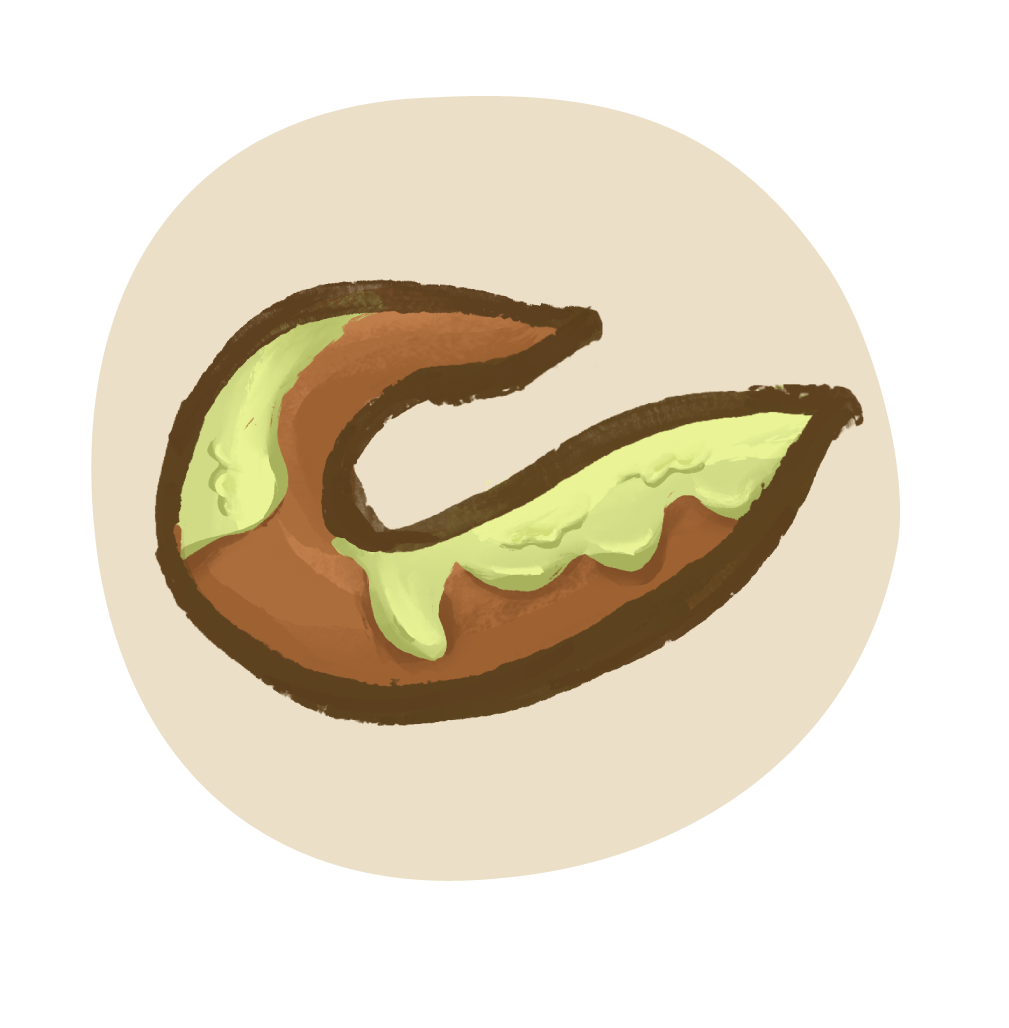
If you find that mucous is coating the stool (like a sausage skin), this may mean a bacterial infection is present and your dog’s digestive system is trying to get rid of something. Monitor for a few days and if it continues it’s time to visit your vet. Stools with a greasy sheen to them can be a sign of too much fat in the diet or the pancreas not digesting fat properly, meaning a vet check or a slight change in diet. Red streaks coating the stool are an indicator of bleeding and again, requires veterinary attention.
Remembering the three C’s of your dog’s 2’s is a great way to monitor your dog’s health, whether they are coping with changes in diet or if it’s time for a vet check-up. We’ve created this visual guide to help determine your dog’s poo type.
If you’re introducing a new diet, or concerned that your dog has the odd ‘not so perfect poo’, download our doggy DooDoo Diary to track their patterns and take to your next vet visit. Remember, it’s not uncommon to see some loose stools when transitioning to a new diet but if it’s persistent or very watery then consult your vet.
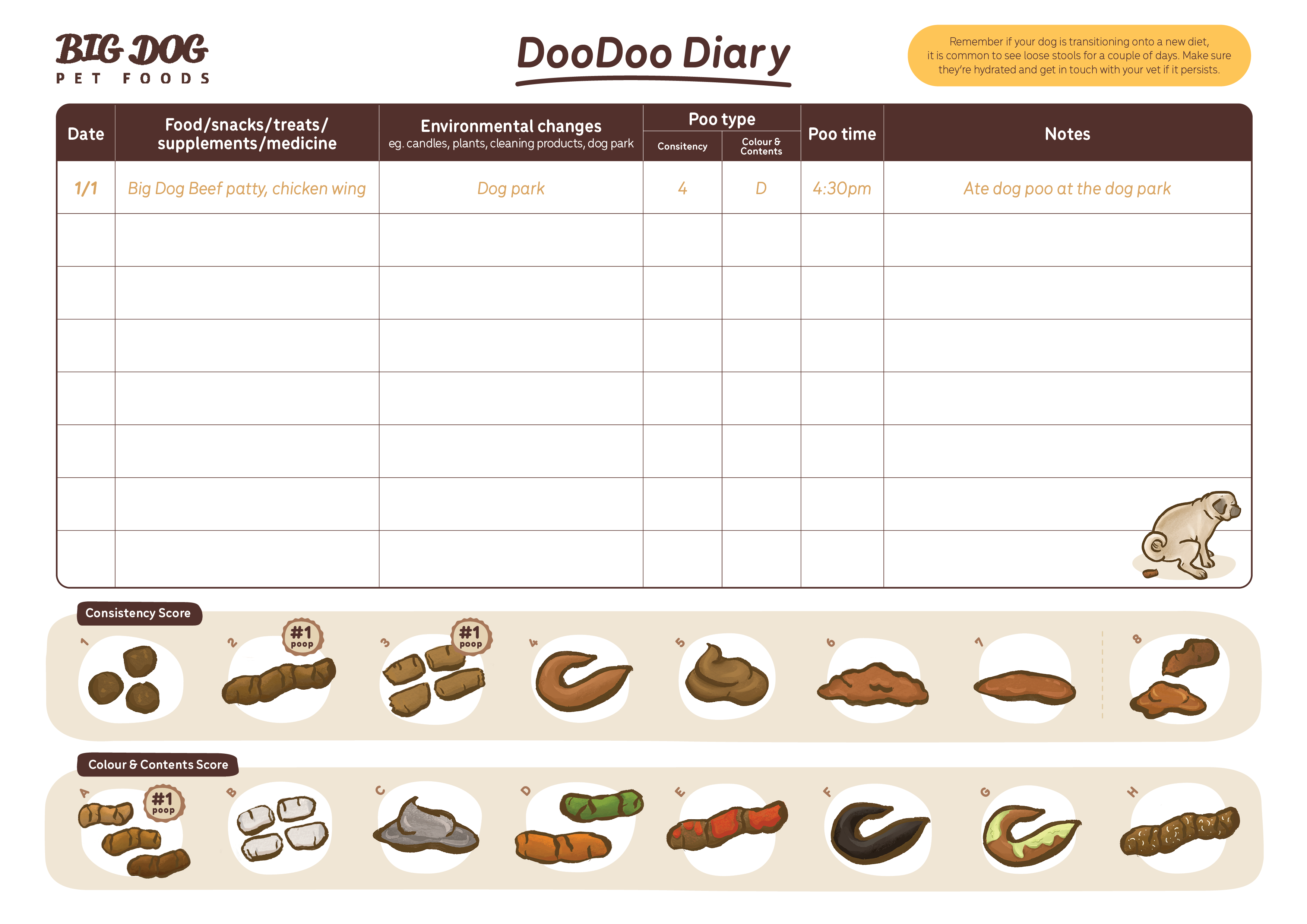
Poo-sitive Reviews
Check out these game-changing (and poo-changing) stories from our customers! Our raw food and probiotics have transformed their health from the inside out.
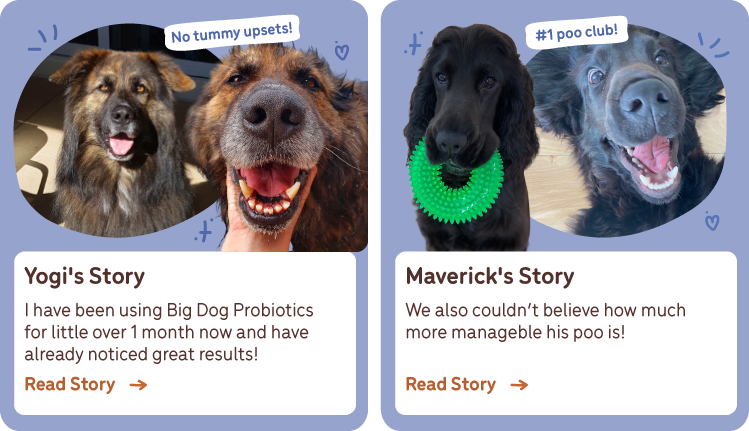
If you were interested in the benefits that a raw food diet can have on your dog’s health, feel free to get in touch with a member of our team here: customercare@bigdogpetfoods.com
If you notice that your pup’s stools closely resemble those pictured above, don’t hesitate to get in touch with your vet.
If you're new to raw feeding and want to learn more check out our beginner's guide to raw feeding.
To learn more about Big Dog's healthy, raw diet for your pet check out range of raw diets for pets.
Probiotics have many health benefits, particularly for digestive support, check out the Big Dog Probiotic Supplements.
To find out where you can buy Big Dog raw food for your pet, visit our Where to Buy Big Dog Pet Foods page.
If you liked this article, sign up to our Big Dog Fam Mail to receive more great pet health and happiness advice.
